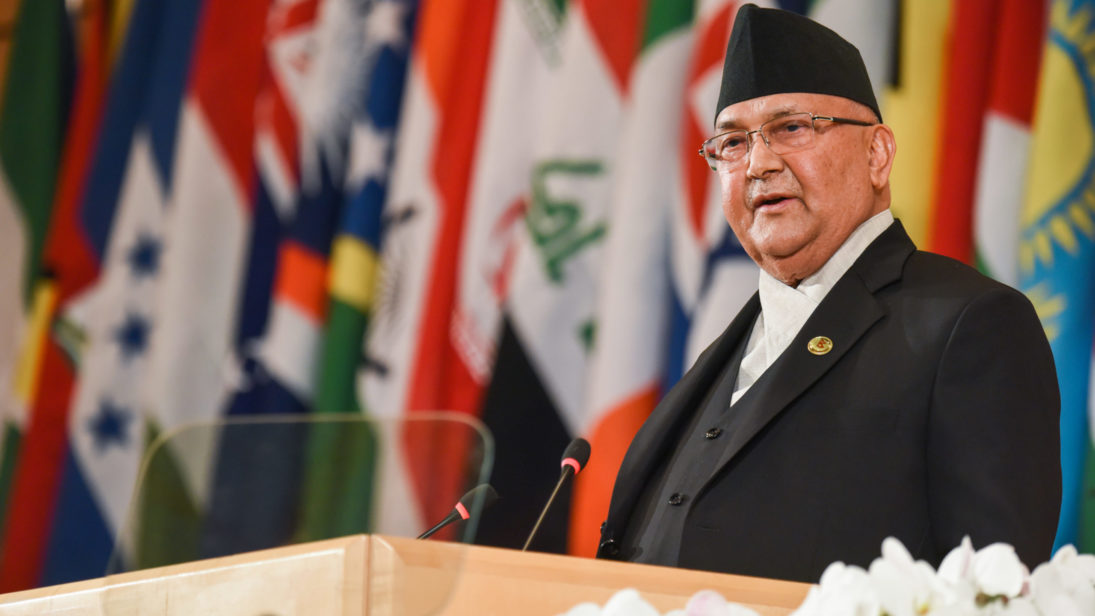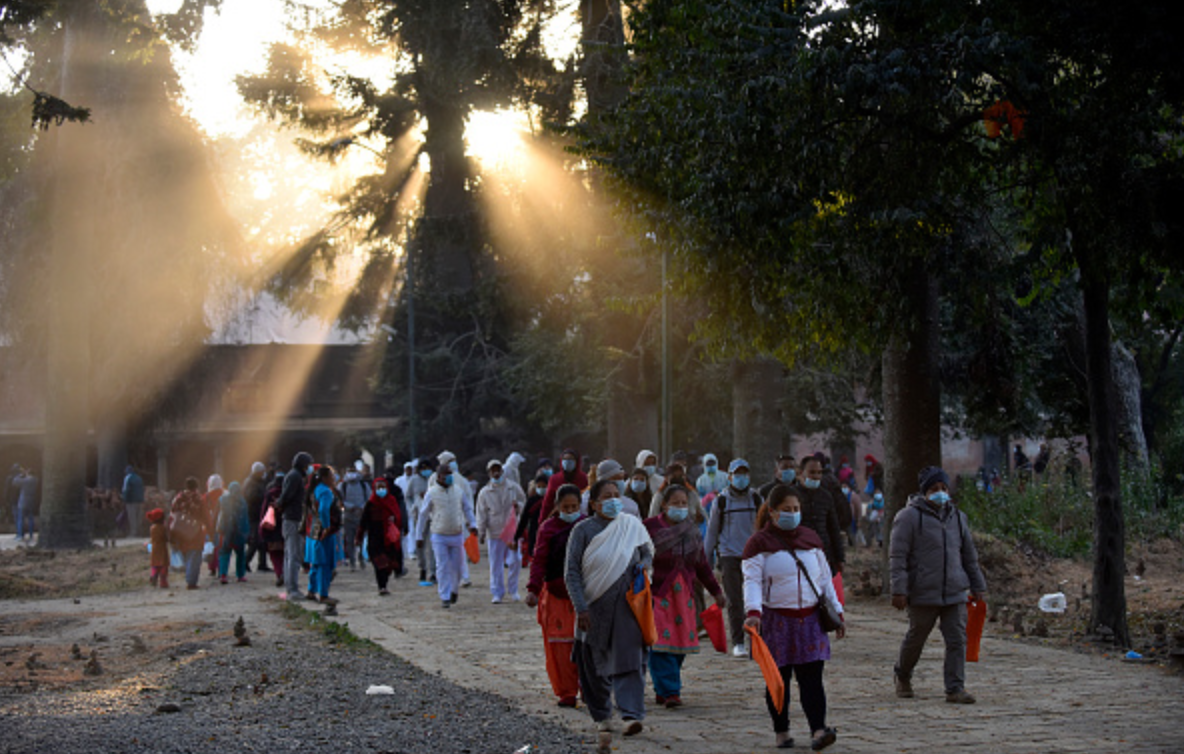
Nepal has been hard-hit by the COVID-19 pandemic over the last year. The government ordered a lockdown and shutdown, among other prohibitory orders, to control the situation and prevent more damage as the pandemic impacted life, polity, and the economy. However, despite its grandstanding, the government did a poor job of handling the pandemic. COVID-19 has taken a heavy toll on the national economy as the tourism industry, an important contributor to Nepal’s GDP, was negatively impacted. The Visit Nepal 2020 campaign—which aimed to draw 2 million foreign visitors this year—had to be called off early.
Despite a slump in economic activities, there was significant movement this year on both the foreign policy and domestic politics fronts. Tensions arose with Nepal’s southern neighbor, India, as the latter opened a road via Lipulekh in May 2020, a territory that Nepal claims its own. Since then, relations remained sour until a flurry of visits by Indian government officials in November. Meanwhile, China continues to maintain its presence and influence, inching closer to the ruling Nepal Communist Party (NCP) at every opportunity. On the domestic politics front, intra-party infighting in the NCP took center stage. If the infighting continues into 2021, a party split might result in the polity’s loss of faith in its leaders and the country’s potential reversion towards political instability.
In a snapshot, 2020 was like a roller coaster ride for Nepal—full of ups and downs. As the pandemic continues to take its toll on the economy and human lives, the ruling NCP is uncertain about the future of the party, and the opposition is absent, lacking a concrete plan to oppose the current ruling party. It will also be important to watch how Nepal’s relations with India and China unfold and how Prime Minister Oli plans to take the country forward amidst a health crisis and infighting within his party.
As the pandemic continues to take its toll on the economy and human lives, the ruling NCP is uncertain about the future of the party, and the opposition is absent, lacking a concrete plan to oppose the current ruling party.
COVID-19’s Impact on Nepal’s Economy and Healthcare
As COVID-19 cases surged globally, Nepal entered a lockdown on March 24 to tackle the deadly pathogen when only two cases were reported in the country. The lockdown, initially supposed to last a week, continued for four months before being lifted, with reservations, on July 21. The suspension of economic activities for such a long time negatively affected both the government and its citizens. A recent survey published by the Nepal Rastra Bank found that only 35 percent of businesses operated partially, while four percent operated fully during the lockdown period (March 24 to July 21). What’s more, industries and businesses slashed 18.2 percent off their payroll, with hotels and restaurants leading the layoffs, followed by transport entrepreneurs and educational institutions.
The government, for its part, announced a number of relief measures, including rescheduling of loan repayment deadlines for the businesses affected. However, the people—especially daily wage workers—were caught in a bind between fighting the virus or fighting hunger. Low-income citizens who have long struggled to make ends meet were doubly affected by the lockdown as no relief packages were specifically targeted to benefit them. A June 2020 World Bank report predicted Nepal’s GDP growth to be at 1.8 percent in FY 2020, compared to seven percent in FY 2019. Over time, the economy has begun humming, but the road to recovery is long and arduous.
Meanwhile, as hospitals continue to be overwhelmed with coronavirus patients, the pandemic has exposed Nepal’s already fractured healthcare system. The government’s response has been inadequate and insufficient, with lapses reported in relief distribution, allegations of corruption in the procurement of medical supplies to combat the pandemic, and the Prime Minister’s repeated peddling of pseudo-science and propagation of home remedies for COVID-19.
Foreign Policy: Relations with India and China
Perhaps wanting to take advantage of Nepal’s economic vulnerability brought on by the pandemic, India unilaterally opened a 50 mile (80 kilometer) road via Lipulekh—a territory claimed by Nepal—on May 8, 2020. But the Himalayan nation reacted sharply. By June 2020, Nepal redrew its political map to incorporate three disputed areas—Kalapani, Limpiyadhura, and Lipulekh—which India maintains are its territorial holdings. The new map, passed unanimously by the Parliament in Nepal, emboldened Prime Minister Oli and citizens’ perceptions of him. Following these actions, the Nepal-India bilateral ties sunk to their lowest point since the blockade of 2015.
The space left by India opened space for China to create additional leverages in the Himalayan country, including the increasing number of meetings by Chinese ambassador with senior Nepali politicians. China continued to woo Nepal even during the pandemic by supplying PCR test kits and other medical equipment and the Himalayan nation fully accepted any support coming from its northern neighbor, in effect increasing China’s influence in the country.
In an effort to balance relations with its neighbors, Nepal has played host to both its northern and southern neighbors. Nepal is now walking a tightrope between India and China as it fears increasing Indian dominance and so seeks China’s support to maintain balance. There will be competition over investment between the Nepal’s two neighbors in the next few years, but Nepal’s ability to maintain balance will undoubtedly require political stability at home with leadership that prioritizes the country’s interests over its own.

Domestic Politics: Intra-Party Disputes
While PM Oli tackled external pressure, troubles arose in his own backyard. The NCP was originally the result of a merger between Oli’s CPN-UML and Dahal’s CPN (Maoist Centre) in May 2018, after which Oli became the Prime Minister and led the strongest government Nepal has seen in the last two-and-a-half-decades. However, numerous clashes between the two co-chairs have done significant harm to the party. Citing the Prime Minister’s inefficacy in properly ruling the party and the government, 30 out of 44 Standing Committee members of the ruling NCP demanded his resignation in June.
This intra-party challenge paved the way for Hou Yanqi, the Chinese ambassador to Nepal, to enmesh herself in the country’s domestic politics . China has only recently begun to involve itself in Nepal’s domestic affairs. In June and July, Ambassador Yanqi met with a number of members of the government and political party leaders of the ruling NCP, urging them to keep the party united. Agreements between Oli and co-chair Pushpa Kamal Dahal to settle differences and forge consensus on power-sharing created the false perception that the internal rift was to some extent settled.
In November, the fight over power-sharing in the NCP took an ugly turn as both chairs stopped talking with each other altogether. Dahal presented a 19-page proposal in the Secretariat meeting accusing PM Oli of flouting party norms and dishonoring the power-sharing deal between the two, to which PM Oli presented a 38-page rebuttal. With this, the fate of the ruling party is uncertain. There have been reports of “secret meetings” between PM Oli and the leader of the main Nepali Congress (NC), Sher Bahadur Deuba, to discuss prospects of a coalition. It appears PM Oli is trying to pre-empt any moves against him by his in-party opponents. Given the corrupt state of the NC, Deuba could fulfill his personal ambition of staying in power by forging an alliance with the NCP, but it remains too early to speculate.
Even in the middle of an unprecedented health emergency, political infighting continues to take precedence over citizens’ lives. COVID-19 cases continue to surge but the Prime Minister, instead of formulating a strategy to cope with the crisis, has occupied himself by designing game plans in an effort to maintain power.
COVID-19 cases continue to surge but the Prime Minister, instead of formulating a strategy to cope with the crisis, has occupied himself by designing game plans in an effort to maintain power.
Conclusion
The pandemic continues to claim lives in Nepal, with the total number of cases reaching 251,692 and the death toll reaching 1,749 at the time of this writing. Economic activities have started picking up, but it is a choice people are making between safety from COVID-19 and starvation. On the foreign policy front in 2020, new developments in domestic politics opened the door to international engagement in Nepal, as evidenced by the number of visits by Indian (intelligence, military, and diplomatic emissaries) and Chinese officials last month. Both states’ meetings with the Prime Minister, President, and various party leader have raised questions about their interests and influence in Nepali politics. Beijing’s interest is more tilted towards keeping the NCP united regardless of its leader, while India’s interest is to regain its sphere of influence to counter China’s increasing presence in the region.
As evidenced from past experience, every time there are problems in Nepal’s ruling party, external actors intervene to their own advantage. Nepal must learn its lesson and ensure its domestic problems are solved internally, without the influence of external actors. There is much at stake; the health emergency has put significant economic pressure on the government as it has suffered losses worth billions and hundreds of thousands have lost their jobs. What’s more, people’s trust in the leadership is waning. The ruling party must keep itself united if it wants to maintain its promise of a stable Nepal marching towards prosperity.
Editor’s Note: SAV contributors from across the subcontinent recap the most significant political, economic, and strategic developments in South Asia in 2020 and analyze what opportunities and challenges lie ahead for each country in 2021. Read the full series here.
***
Image 1: International Labour Organization ILO via Flickr
Image 2: NurPhoto via Getty Images


